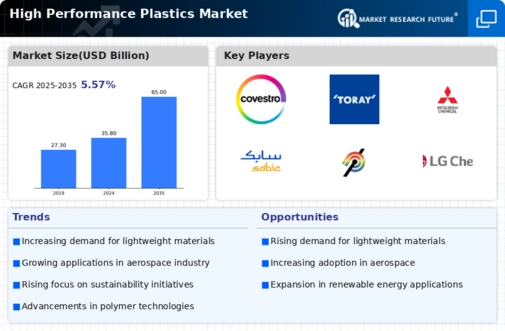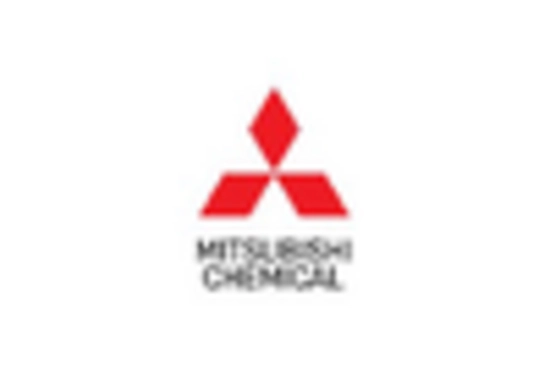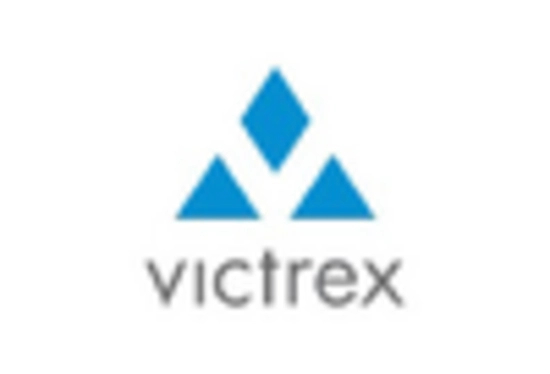Aerospace
Automotive
Electronics
Medical
Industrial
Polyetheretherketone
Polysulfone
Polyimide
Fluoropolymers
Engineering Thermoplastics
Consumer Goods
Transportation
Healthcare
Electrical Electronics
Construction
Injection Molding
Extrusion
Blow Molding
Thermoforming
3D Printing
North America
Europe
South America
Asia Pacific
Middle East and Africa
North America Outlook (USD Billion, 2019-2035)
North America High Performance Plastics Market by Application Type
Aerospace
Automotive
Electronics
Medical
Industrial
North America High Performance Plastics Market by Type
Polyetheretherketone
Polysulfone
Polyimide
Fluoropolymers
Engineering Thermoplastics
North America High Performance Plastics Market by End Use Type
Consumer Goods
Transportation
Healthcare
Electrical Electronics
Construction
North America High Performance Plastics Market by Processing Method Type
Injection Molding
Extrusion
Blow Molding
Thermoforming
3D Printing
North America High Performance Plastics Market by Regional Type
US
Canada
US Outlook (USD Billion, 2019-2035)
US High Performance Plastics Market by Application Type
Aerospace
Automotive
Electronics
Medical
Industrial
US High Performance Plastics Market by Type
Polyetheretherketone
Polysulfone
Polyimide
Fluoropolymers
Engineering Thermoplastics
US High Performance Plastics Market by End Use Type
Consumer Goods
Transportation
Healthcare
Electrical Electronics
Construction
US High Performance Plastics Market by Processing Method Type
Injection Molding
Extrusion
Blow Molding
Thermoforming
3D Printing
CANADA Outlook (USD Billion, 2019-2035)
CANADA High Performance Plastics Market by Application Type
Aerospace
Automotive
Electronics
Medical
Industrial
CANADA High Performance Plastics Market by Type
Polyetheretherketone
Polysulfone
Polyimide
Fluoropolymers
Engineering Thermoplastics
CANADA High Performance Plastics Market by End Use Type
Consumer Goods
Transportation
Healthcare
Electrical Electronics
Construction
CANADA High Performance Plastics Market by Processing Method Type
Injection Molding
Extrusion
Blow Molding
Thermoforming
3D Printing
Europe Outlook (USD Billion, 2019-2035)
Europe High Performance Plastics Market by Application Type
Aerospace
Automotive
Electronics
Medical
Industrial
Europe High Performance Plastics Market by Type
Polyetheretherketone
Polysulfone
Polyimide
Fluoropolymers
Engineering Thermoplastics
Europe High Performance Plastics Market by End Use Type
Consumer Goods
Transportation
Healthcare
Electrical Electronics
Construction
Europe High Performance Plastics Market by Processing Method Type
Injection Molding
Extrusion
Blow Molding
Thermoforming
3D Printing
Europe High Performance Plastics Market by Regional Type
Germany
UK
France
Russia
Italy
Spain
Rest of Europe
GERMANY Outlook (USD Billion, 2019-2035)
GERMANY High Performance Plastics Market by Application Type
Aerospace
Automotive
Electronics
Medical
Industrial
GERMANY High Performance Plastics Market by Type
Polyetheretherketone
Polysulfone
Polyimide
Fluoropolymers
Engineering Thermoplastics
GERMANY High Performance Plastics Market by End Use Type
Consumer Goods
Transportation
Healthcare
Electrical Electronics
Construction
GERMANY High Performance Plastics Market by Processing Method Type
Injection Molding
Extrusion
Blow Molding
Thermoforming
3D Printing
UK Outlook (USD Billion, 2019-2035)
UK High Performance Plastics Market by Application Type
Aerospace
Automotive
Electronics
Medical
Industrial
UK High Performance Plastics Market by Type
Polyetheretherketone
Polysulfone
Polyimide
Fluoropolymers
Engineering Thermoplastics
UK High Performance Plastics Market by End Use Type
Consumer Goods
Transportation
Healthcare
Electrical Electronics
Construction
UK High Performance Plastics Market by Processing Method Type
Injection Molding
Extrusion
Blow Molding
Thermoforming
3D Printing
FRANCE Outlook (USD Billion, 2019-2035)
FRANCE High Performance Plastics Market by Application Type
Aerospace
Automotive
Electronics
Medical
Industrial
FRANCE High Performance Plastics Market by Type
Polyetheretherketone
Polysulfone
Polyimide
Fluoropolymers
Engineering Thermoplastics
FRANCE High Performance Plastics Market by End Use Type
Consumer Goods
Transportation
Healthcare
Electrical Electronics
Construction
FRANCE High Performance Plastics Market by Processing Method Type
Injection Molding
Extrusion
Blow Molding
Thermoforming
3D Printing
RUSSIA Outlook (USD Billion, 2019-2035)
RUSSIA High Performance Plastics Market by Application Type
Aerospace
Automotive
Electronics
Medical
Industrial
RUSSIA High Performance Plastics Market by Type
Polyetheretherketone
Polysulfone
Polyimide
Fluoropolymers
Engineering Thermoplastics
RUSSIA High Performance Plastics Market by End Use Type
Consumer Goods
Transportation
Healthcare
Electrical Electronics
Construction
RUSSIA High Performance Plastics Market by Processing Method Type
Injection Molding
Extrusion
Blow Molding
Thermoforming
3D Printing
ITALY Outlook (USD Billion, 2019-2035)
ITALY High Performance Plastics Market by Application Type
Aerospace
Automotive
Electronics
Medical
Industrial
ITALY High Performance Plastics Market by Type
Polyetheretherketone
Polysulfone
Polyimide
Fluoropolymers
Engineering Thermoplastics
ITALY High Performance Plastics Market by End Use Type
Consumer Goods
Transportation
Healthcare
Electrical Electronics
Construction
ITALY High Performance Plastics Market by Processing Method Type
Injection Molding
Extrusion
Blow Molding
Thermoforming
3D Printing
SPAIN Outlook (USD Billion, 2019-2035)
SPAIN High Performance Plastics Market by Application Type
Aerospace
Automotive
Electronics
Medical
Industrial
SPAIN High Performance Plastics Market by Type
Polyetheretherketone
Polysulfone
Polyimide
Fluoropolymers
Engineering Thermoplastics
SPAIN High Performance Plastics Market by End Use Type
Consumer Goods
Transportation
Healthcare
Electrical Electronics
Construction
SPAIN High Performance Plastics Market by Processing Method Type
Injection Molding
Extrusion
Blow Molding
Thermoforming
3D Printing
REST OF EUROPE Outlook (USD Billion, 2019-2035)
REST OF EUROPE High Performance Plastics Market by Application Type
Aerospace
Automotive
Electronics
Medical
Industrial
REST OF EUROPE High Performance Plastics Market by Type
Polyetheretherketone
Polysulfone
Polyimide
Fluoropolymers
Engineering Thermoplastics
REST OF EUROPE High Performance Plastics Market by End Use Type
Consumer Goods
Transportation
Healthcare
Electrical Electronics
Construction
REST OF EUROPE High Performance Plastics Market by Processing Method Type
Injection Molding
Extrusion
Blow Molding
Thermoforming
3D Printing
APAC Outlook (USD Billion, 2019-2035)
APAC High Performance Plastics Market by Application Type
Aerospace
Automotive
Electronics
Medical
Industrial
APAC High Performance Plastics Market by Type
Polyetheretherketone
Polysulfone
Polyimide
Fluoropolymers
Engineering Thermoplastics
APAC High Performance Plastics Market by End Use Type
Consumer Goods
Transportation
Healthcare
Electrical Electronics
Construction
APAC High Performance Plastics Market by Processing Method Type
Injection Molding
Extrusion
Blow Molding
Thermoforming
3D Printing
APAC High Performance Plastics Market by Regional Type
China
India
Japan
South Korea
Malaysia
Thailand
Indonesia
Rest of APAC
CHINA Outlook (USD Billion, 2019-2035)
CHINA High Performance Plastics Market by Application Type
Aerospace
Automotive
Electronics
Medical
Industrial
CHINA High Performance Plastics Market by Type
Polyetheretherketone
Polysulfone
Polyimide
Fluoropolymers
Engineering Thermoplastics
CHINA High Performance Plastics Market by End Use Type
Consumer Goods
Transportation
Healthcare
Electrical Electronics
Construction
CHINA High Performance Plastics Market by Processing Method Type
Injection Molding
Extrusion
Blow Molding
Thermoforming
3D Printing
INDIA Outlook (USD Billion, 2019-2035)
INDIA High Performance Plastics Market by Application Type
Aerospace
Automotive
Electronics
Medical
Industrial
INDIA High Performance Plastics Market by Type
Polyetheretherketone
Polysulfone
Polyimide
Fluoropolymers
Engineering Thermoplastics
INDIA High Performance Plastics Market by End Use Type
Consumer Goods
Transportation
Healthcare
Electrical Electronics
Construction
INDIA High Performance Plastics Market by Processing Method Type
Injection Molding
Extrusion
Blow Molding
Thermoforming
3D Printing
JAPAN Outlook (USD Billion, 2019-2035)
JAPAN High Performance Plastics Market by Application Type
Aerospace
Automotive
Electronics
Medical
Industrial
JAPAN High Performance Plastics Market by Type
Polyetheretherketone
Polysulfone
Polyimide
Fluoropolymers
Engineering Thermoplastics
JAPAN High Performance Plastics Market by End Use Type
Consumer Goods
Transportation
Healthcare
Electrical Electronics
Construction
JAPAN High Performance Plastics Market by Processing Method Type
Injection Molding
Extrusion
Blow Molding
Thermoforming
3D Printing
SOUTH KOREA Outlook (USD Billion, 2019-2035)
SOUTH KOREA High Performance Plastics Market by Application Type
Aerospace
Automotive
Electronics
Medical
Industrial
SOUTH KOREA High Performance Plastics Market by Type
Polyetheretherketone
Polysulfone
Polyimide
Fluoropolymers
Engineering Thermoplastics
SOUTH KOREA High Performance Plastics Market by End Use Type
Consumer Goods
Transportation
Healthcare
Electrical Electronics
Construction
SOUTH KOREA High Performance Plastics Market by Processing Method Type
Injection Molding
Extrusion
Blow Molding
Thermoforming
3D Printing
MALAYSIA Outlook (USD Billion, 2019-2035)
MALAYSIA High Performance Plastics Market by Application Type
Aerospace
Automotive
Electronics
Medical
Industrial
MALAYSIA High Performance Plastics Market by Type
Polyetheretherketone
Polysulfone
Polyimide
Fluoropolymers
Engineering Thermoplastics
MALAYSIA High Performance Plastics Market by End Use Type
Consumer Goods
Transportation
Healthcare
Electrical Electronics
Construction
MALAYSIA High Performance Plastics Market by Processing Method Type
Injection Molding
Extrusion
Blow Molding
Thermoforming
3D Printing
THAILAND Outlook (USD Billion, 2019-2035)
THAILAND High Performance Plastics Market by Application Type
Aerospace
Automotive
Electronics
Medical
Industrial
THAILAND High Performance Plastics Market by Type
Polyetheretherketone
Polysulfone
Polyimide
Fluoropolymers
Engineering Thermoplastics
THAILAND High Performance Plastics Market by End Use Type
Consumer Goods
Transportation
Healthcare
Electrical Electronics
Construction
THAILAND High Performance Plastics Market by Processing Method Type
Injection Molding
Extrusion
Blow Molding
Thermoforming
3D Printing
INDONESIA Outlook (USD Billion, 2019-2035)
INDONESIA High Performance Plastics Market by Application Type
Aerospace
Automotive
Electronics
Medical
Industrial
INDONESIA High Performance Plastics Market by Type
Polyetheretherketone
Polysulfone
Polyimide
Fluoropolymers
Engineering Thermoplastics
INDONESIA High Performance Plastics Market by End Use Type
Consumer Goods
Transportation
Healthcare
Electrical Electronics
Construction
INDONESIA High Performance Plastics Market by Processing Method Type
Injection Molding
Extrusion
Blow Molding
Thermoforming
3D Printing
REST OF APAC Outlook (USD Billion, 2019-2035)
REST OF APAC High Performance Plastics Market by Application Type
Aerospace
Automotive
Electronics
Medical
Industrial
REST OF APAC High Performance Plastics Market by Type
Polyetheretherketone
Polysulfone
Polyimide
Fluoropolymers
Engineering Thermoplastics
REST OF APAC High Performance Plastics Market by End Use Type
Consumer Goods
Transportation
Healthcare
Electrical Electronics
Construction
REST OF APAC High Performance Plastics Market by Processing Method Type
Injection Molding
Extrusion
Blow Molding
Thermoforming
3D Printing
South America Outlook (USD Billion, 2019-2035)
South America High Performance Plastics Market by Application Type
Aerospace
Automotive
Electronics
Medical
Industrial
South America High Performance Plastics Market by Type
Polyetheretherketone
Polysulfone
Polyimide
Fluoropolymers
Engineering Thermoplastics
South America High Performance Plastics Market by End Use Type
Consumer Goods
Transportation
Healthcare
Electrical Electronics
Construction
South America High Performance Plastics Market by Processing Method Type
Injection Molding
Extrusion
Blow Molding
Thermoforming
3D Printing
South America High Performance Plastics Market by Regional Type
Brazil
Mexico
Argentina
Rest of South America
BRAZIL Outlook (USD Billion, 2019-2035)
BRAZIL High Performance Plastics Market by Application Type
Aerospace
Automotive
Electronics
Medical
Industrial
BRAZIL High Performance Plastics Market by Type
Polyetheretherketone
Polysulfone
Polyimide
Fluoropolymers
Engineering Thermoplastics
BRAZIL High Performance Plastics Market by End Use Type
Consumer Goods
Transportation
Healthcare
Electrical Electronics
Construction
BRAZIL High Performance Plastics Market by Processing Method Type
Injection Molding
Extrusion
Blow Molding
Thermoforming
3D Printing
MEXICO Outlook (USD Billion, 2019-2035)
MEXICO High Performance Plastics Market by Application Type
Aerospace
Automotive
Electronics
Medical
Industrial
MEXICO High Performance Plastics Market by Type
Polyetheretherketone
Polysulfone
Polyimide
Fluoropolymers
Engineering Thermoplastics
MEXICO High Performance Plastics Market by End Use Type
Consumer Goods
Transportation
Healthcare
Electrical Electronics
Construction
MEXICO High Performance Plastics Market by Processing Method Type
Injection Molding
Extrusion
Blow Molding
Thermoforming
3D Printing
ARGENTINA Outlook (USD Billion, 2019-2035)
ARGENTINA High Performance Plastics Market by Application Type
Aerospace
Automotive
Electronics
Medical
Industrial
ARGENTINA High Performance Plastics Market by Type
Polyetheretherketone
Polysulfone
Polyimide
Fluoropolymers
Engineering Thermoplastics
ARGENTINA High Performance Plastics Market by End Use Type
Consumer Goods
Transportation
Healthcare
Electrical Electronics
Construction
ARGENTINA High Performance Plastics Market by Processing Method Type
Injection Molding
Extrusion
Blow Molding
Thermoforming
3D Printing
REST OF SOUTH AMERICA Outlook (USD Billion, 2019-2035)
REST OF SOUTH AMERICA High Performance Plastics Market by Application Type
Aerospace
Automotive
Electronics
Medical
Industrial
REST OF SOUTH AMERICA High Performance Plastics Market by Type
Polyetheretherketone
Polysulfone
Polyimide
Fluoropolymers
Engineering Thermoplastics
REST OF SOUTH AMERICA High Performance Plastics Market by End Use Type
Consumer Goods
Transportation
Healthcare
Electrical Electronics
Construction
REST OF SOUTH AMERICA High Performance Plastics Market by Processing Method Type
Injection Molding
Extrusion
Blow Molding
Thermoforming
3D Printing
MEA Outlook (USD Billion, 2019-2035)
MEA High Performance Plastics Market by Application Type
Aerospace
Automotive
Electronics
Medical
Industrial
MEA High Performance Plastics Market by Type
Polyetheretherketone
Polysulfone
Polyimide
Fluoropolymers
Engineering Thermoplastics
MEA High Performance Plastics Market by End Use Type
Consumer Goods
Transportation
Healthcare
Electrical Electronics
Construction
MEA High Performance Plastics Market by Processing Method Type
Injection Molding
Extrusion
Blow Molding
Thermoforming
3D Printing
MEA High Performance Plastics Market by Regional Type
GCC Countries
South Africa
Rest of MEA
GCC COUNTRIES Outlook (USD Billion, 2019-2035)
GCC COUNTRIES High Performance Plastics Market by Application Type
Aerospace
Automotive
Electronics
Medical
Industrial
GCC COUNTRIES High Performance Plastics Market by Type
Polyetheretherketone
Polysulfone
Polyimide
Fluoropolymers
Engineering Thermoplastics
GCC COUNTRIES High Performance Plastics Market by End Use Type
Consumer Goods
Transportation
Healthcare
Electrical Electronics
Construction
GCC COUNTRIES High Performance Plastics Market by Processing Method Type
Injection Molding
Extrusion
Blow Molding
Thermoforming
3D Printing
SOUTH AFRICA Outlook (USD Billion, 2019-2035)
SOUTH AFRICA High Performance Plastics Market by Application Type
Aerospace
Automotive
Electronics
Medical
Industrial
SOUTH AFRICA High Performance Plastics Market by Type
Polyetheretherketone
Polysulfone
Polyimide
Fluoropolymers
Engineering Thermoplastics
SOUTH AFRICA High Performance Plastics Market by End Use Type
Consumer Goods
Transportation
Healthcare
Electrical Electronics
Construction
SOUTH AFRICA High Performance Plastics Market by Processing Method Type
Injection Molding
Extrusion
Blow Molding
Thermoforming
3D Printing
REST OF MEA Outlook (USD Billion, 2019-2035)
REST OF MEA High Performance Plastics Market by Application Type
Aerospace
Automotive
Electronics
Medical
Industrial
REST OF MEA High Performance Plastics Market by Type
Polyetheretherketone
Polysulfone
Polyimide
Fluoropolymers
Engineering Thermoplastics
REST OF MEA High Performance Plastics Market by End Use Type
Consumer Goods
Transportation
Healthcare
Electrical Electronics
Construction
REST OF MEA High Performance Plastics Market by Processing Method Type
Injection Molding
Extrusion
Blow Molding
Thermoforming
3D Printing

















Leave a Comment